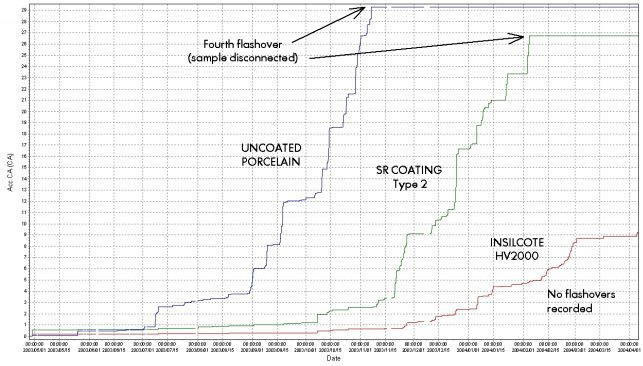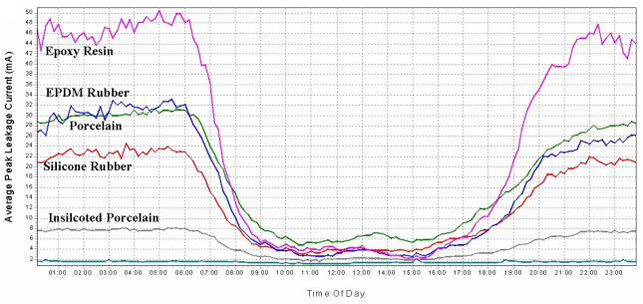We are Manufacturer, Supplier, Exporter of RTV Silicone Rubber Coatings, Anti Flashover Coatings & our setup is situated in Pune, Maharashtra, India
INSILCOTE is a unique Room Temperature Vulcanised, (RTV) silicone rubber formulation, specifically developed by Mace Technologies, South Africa, in collaboration with the Electric Power Research Group of the University of the Witwatersrand for the prevention of pollution flashover of high voltage outdoor insulation.
The exceptional hydrophobicity of INSILCOTE inhibits the formation of continuous moist conductive layers on insulator surfaces. This, in turn, limits the flow of leakage currents, thus preventing the creation of dry bands and partial discharges - critical steps in the flashover process.
The superior performance of silicone rubber over other insulating materials in polluted environments is well proven. What makes silicone unique is the fact that, owing to the migration of low molecular weight siloxanes that exist within the elastomer, the water repellent properties are imparted to contaminants which accumulate on the surface. Thus, even when covered with a thick pollutions deposit, hydrophobicity is maintained.
The exceptional water-repellency of INSILCOTE and its rapid transfer of this characteristic to any covering contamination layer, coupled with silicone's inherent resistance to degradation by ultra-violet radiation, ozone and most chemicals, combination with the use of specialised fillers to combat power arc damage, enables the material to provide enhanced system reliability over a period of many years, even in the most extreme environments.
Since its release to the market in 1991, INSILCOTE has been in service atover 300 sites in the most polluted areas of Southern Africa, and has also found application in Europe, North America, Australasia, India and the Middle East. No flashovers of the treated insulators have been experienced.
The adoption of INSILCOTE has ranged from small 11kV Substations to complete 400kV Transmission Stations and 533kVDC Converter Stations. The operating environments include marine salt fogs, coastal desert conditions, heavily industrialised sites with, for example, acidic emissions, coal-fired, power station fall-out and heavy cement dust contamination, and agricultural areas characterised by sugar cane burning and crop-spraying the use of highly conductive fertilisers and weedkillers.
The superiority of INSILCOTE has been well illustrated by comprehensive evaluations of Coating meterials undertaken by Eskom at their Koeberg Insulator Pollution Testing Station where energised insulators are exposed to the extreme marine conditions characteristic of the site. Chart - A shows the cumulative leakage current flow over a one year period, on three identical insulators - two of which are coated with different brands of silicone rubber and the third left uncoated. It is evident that the silicone rubber significantly improves the insulator performance and, further, that INSILCOTE provided the gratest protection.

Chart - A

Chart - B
The average time-of-day leakage current amplitude measured over a period of one year on a porcelain insulator coated with INSILCOTE compared to geometrically identical units but of different materials, is illustrated in Chart - B. It is interesting to note that the leakage currents amplitudes on the coated porcelain are significantly less than even the silicone rubber composite unit.
For improved performance, and a controlled cure at room temperature, INSILCOTE is a two-part material, i.e. a small volume of catalyst provided is poured into the coating before application.
Unlike those materials utilising an oxime cross-linking agent, the INSILCOTE'Scuring system has the benefits of not requiring any atmospheric moisture for vulcanisation to take place, the cure rate is independent of humidity, no by-products are released on curing and there is practically no shrinkage (< 0, 1% versus 0,5% to 1% for oxime systems). The shelf life is also much longer than single-part rubbers.
The coating is designed for spray application to give an optimum layer thickness of 0,3 to 0,5mm and a smooth, uniform, high quality finish.
Although the coating does have some adhesion to porcelain and glass, the application of INSILCOTE Primer, which is supplied with the coating is recommended to provide a strong permanent bond to all ceramic, glass and resin materials. If a separate primer is not used, the bonding agent must be included in the coating. This, of course, replaces some of the silicone and thus adversely affects the material performance and longevity. With the INSILCOTE system, the primer is applied only at the interface between the insulator and the coating where it is needed, and leave the rubber layer itself free of unnecessary materials.
Sr. No |
Parameters |
INSILCOTE HV2000 |
| 1 | Application Area | 11 kV to 400 kV AC & 533 kV DC insulators of Porcelain, Glass, Resin material, Ceramic make. |
| 2 | Dielectric Strength (BDV) kV/mm | 64 kV/mm |
| 3 | Viscosity | 33.5 cSt |
| 4 | Specific Gravity (wet) | 1.33 |
| 5 | Specific Gravity (Cured) | 1.24 at 25 deg. C. |
| 6 | Permittivity | 2.4 |
| 7 | Dielectric Constant | 2.4 |
| 8 | Surface Resitivity | 1.15 x 10¹³ Ohms |
| 9 | Volume Resitivity | 2.29 x 10¹³ Ohm-meter |
| 10 | Loss Tangent | 0.0096 at 50 Hz |
| 11 | Dissipation Factor | 0.0096 at 50 Hz |
| 12 | Touch Dry | 15 min. |
| 13 | Full Cure Time | 7 Hrs |
| 14 | Required Dry Thickness | 0.3 to 0.5 mm |
| 15 | Application Method | Spray gun |
| 16 | Appearance after mixing | Light Blue |
| 17 | Resistance to … | Marine salt fog, Industrial, Agricultural, Coastal & Desert conditions, Water, U.V., Chemical, Acid, Abrasion. |
| 18 | Surface Smooth | Yes |
| 19 | Hazardous | UN 1866 & UN 1993 |
| 20 | Coverage Area / Kg. | 2.35 sq. meters. |
| 21 | Shelf Life | 1yr |
